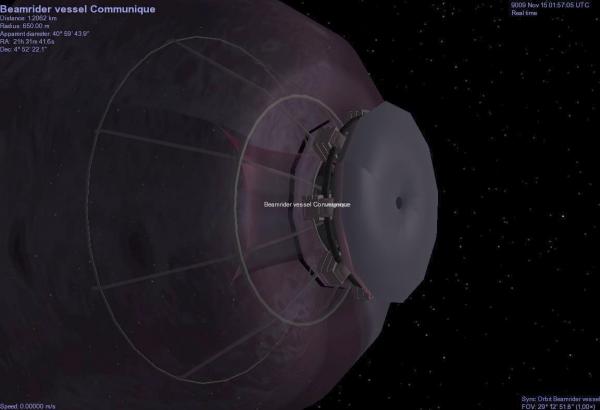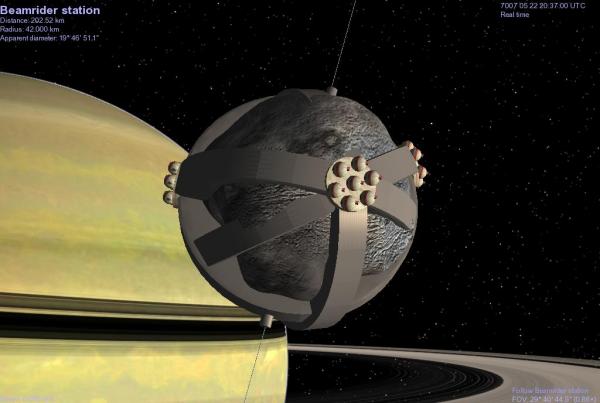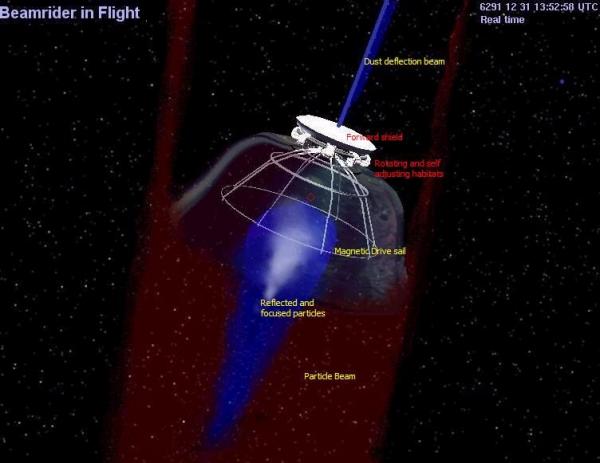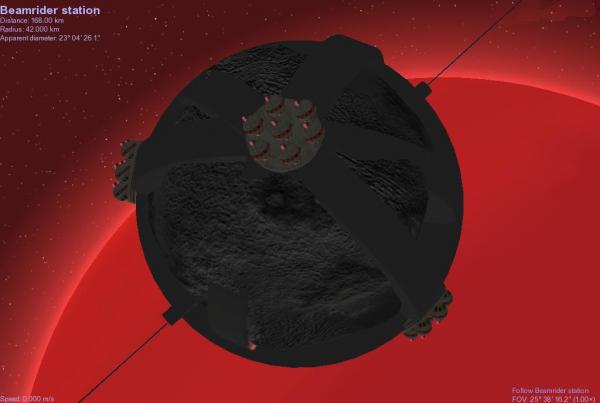BY LETTER
Beamrider Network
Galactography > Other Major Polities, Empires, and Meta-Empires > Deeper Covenant
Technology > Technology Type or Material > Drytech/Hylotech
Technology > Technology Levels > High Tech / Hitech
Technology > Application > Transportation > Interstellar Transport
Technology > Application > Megascale Engineering
Technology > Technology Type or Material > Drytech/Hylotech
Technology > Technology Levels > High Tech / Hitech
Technology > Application > Transportation > Interstellar Transport
Technology > Application > Megascale Engineering
 Image from Steve Bowers | |
| A Beamrider Vessel spreads its magnetic sail | |
The idea of an interstellar mass beam propulsion network was first conceived in the mid first century AT (late 20th and early 21st centuries c.e.). Today there are more beamrider routes than wormholes in the galaxy as a whole.
The Network uses arrays of mass beam projectors (also known as Boostbeams) to magnetically accelerate self-maneuvering "smart dust" micropellets to near light speed and direct them toward a vessel equipped with a powerful magnetic plasma sail. The pellets vaporize upon impact with the magsail and transfer their momentum to the craft, accelerating it to a significant percentage of lightspeed. Once accelerated up to cruising speed, the beamrider coasts on a course that takes it past a series of stars, brown dwarfs, and free-floating extra-solar planets. Additional mass-beam booster stations are built on and around these objects. Using a combination of the galactic magnetic field, onboard fuel, and mass beams from the booster stations, the beamrider is able to curve its course in a great arc back to its starting point, which is now used as another booster station to send the vessel around the circuit once again.
As the beamrider passes near each of the booster stations, additional cargo, passenger, and resupply pods are accelerated to match velocity with the ship or are dropped off to be decelerated into the target system. Although the energy required to accelerate/decelerate the pods is considerable, it is far less than that required to constantly boost and decelerate entire self- sufficient spacecraft intended to survive years-long journeys between the stars all by themselves. The Network makes a huge initial investment to boost the main vessel up to speed to take advantage of the much greater savings later.
Beamrider links rarely operate with just a single vessel in the circuit. Rather a great many vessels are boosted up over time so that a constant stream of ships is passing along the network. This ensures that a vessel passes by each station at regular intervals, usually ranging from every six months to every three years on most routes.
History
The first section of what would eventually become the Beamrider Network was conceived during the Interplanetary Age . However, it was not until 460 AT that construction of the first launchers was begun by the Cis-Lunar Alliance at the Venus L4 point. The program suffered from lack of funds, since most investment at the time was going into the more financially lucrative Nova Terra Project involving the colonization of Tau Ceti.While this was going on, the Gengineer Republic (based around Jupiter) selected the red dwarf as its destination, and began constructing beam stations around Jupiter and Uranus in 465 AT, powered by the magnetic fields of those worlds. It was intended that from Struve 2398 the circuit would be extended to a number of more distant candidates, eventually curving back towards Sol and creating a cycler route. The Martian Union meanwhile was kept its options open by supporting both projects. Martians were among the crew on both the Cis-Lunar and Gengineer missions.
In 472 AT the Gengineer-Martian vessel Advance was launched towards Struve 2398 (arriving in 637 AT), and in 481 a combined cyborg and ai Cis-Lunar Alliance team aboard the Karl Schroeder was launched towards Ross 128, (arriving in 642 AT). A much later and significantly faster Cislunar Alliance ship arrived at Wolf 359 in 628 AT, making it the first of these beamrider craft to arrive at its destination.
All these missions were launched with the intention of constructing beamrider links back to Solsys as a first priority. But during the flights the situation in Solsys became dangerous, first with the Technocalypse and then the Great Expulsion occurring and creating havoc. The newly arrived colonists decided to construct their beam stations, but with the purpose of boosting ships further away from Sol. Missions were launched in due course to a number of nearby red and brown dwarfs, such as Yin, Yang, Patala, Praxis and Gnosis.
Records on this point are sketchy, but one thing is certain: after the Technocalypse, the crew and support staff of the Cis-Lunar mass-beam facility gathered their families and community together and used the beam projectors to launch themselves toward Ross 128 and out of the Solar System. Shortly after that GAIA appropriated all the beam projectors 'for safety reasons'.
It was not until the First Federation era, after control of the Solar System had been regained and additional interstellar vessels launched, that contact was reestablished with the descendants of the erstwhile colonists and construction workers living around Yin, Yang, Ross 128, Patala, Praxis and Gnosis, Wolf 359 and Struve 2398. During their long isolation, they had managed to both extend their respective networks and maintain contact with each other, although no complete cycler route had yet been finished. Since it was considered too dangerous to cycle through SolSys, several other routes had been attempted, including a Procyon link, but many of these had faced hostile isolationist AI and the projects blocked.
After centuries of being cut off from Sol, the inhabitants of the cycler systems represented a unique developing civilization that was eager to rejoin galactic society, while at the same time maintaining the unique culture and identity they had developed while living on their own. Perhaps more importantly, they desired to continue the great projects they had begun so long ago, but with the help of First Federation technology and ai to accelerate things. With the resources available to them through the new technologies, they set about the work with renewed vigor, sometimes on their own, sometimes with the help of idealistic First Federation ai and hu visionaries. The seeds of what would become the modern Beamrider Network and the Deeper Covenant were born.
 Image from Steve Bowers | |
| A Beamrider Station showing several beam projector arrays | |
The Beamrider Network Today
The modern Beamrider Network extends across approximately a third of explored space and passes near just over a hundred million stars, brown dwarves, and extra-solar planets. Nearly all of these systems are inhabited by members of the Deeper Covenant.Modern beamriders are huge vessels, often extending across hundreds of kilometers of space. Most of the ships' great size is made up of superconducting cables spread out across space with habitat modules affixed near the center of the meshwork. Most ships rotate and individual modules are attached at points where the local gravity is at the desired level.
Despite their impressive dimensions, beamriders are actually rather small by modern standards. Even the largest vessels rarely have a complement of passengers and crew larger than a few hundred people, most of them travelling in biostasis (It is common practice on most ships for passengers and crew to spend 1/3 of the trip awake. Random shuffling of stasis/waking schedules ensures that a traveler will meet at least some new people with each awakening. More than a few people can report that they met their mate or a great romance while travelling aboard a beamrider).
 Image from Steve Bowers | |
| The smart particles used in modern Beamrider systems remain tightly collimated over interstellar distances, and when they reach the magnetic sail of the beamrider they transfer much of their momentum to the vessel | |
In the past, beamriders employed a variety of shielding methods to protect themselves against radiation and interstellar debris. Shields were initially a combination of magnetic fields and ionization lasers. Also a plasma screen, consisting of a portion of the vaporized incoming mass stream that was allowed to 'slip thru' the magsail, was fired ahead of the ship and acted to vaporize any larger particles encountered. As a last resort the ship employed powerful radar to locate larger bodies and would then use a combination of magnetic 'tacking' and onboard thrusters to dodge the object in question. At a standard cruise speed of .3 c there was generally time to maneuver at least a little.
In the modern era most beamriders use a combination of magnetic and plasma shields backed up by Emple-dokcetic shielding. A very few ships rely solely on Emple-dokcetic shields, but most crews reject the idea of depending on but a single method to protect themselves and their passengers.
Standard cruising speed for a modern beamrider is .5c although smaller, faster 'hot beam' vessels can achieve speeds as high as .9c.
Throughout most of the history of mindkind the Beamrider Network has provided a constant, if unobtrusive method of travelling between the stars. Although the development of conversion drive, reactionless drives, and wormholes has diverted some traffic from the Network, the majority of systems in the Nexus still make some use of it, if only for recreational purposes. For the majority of isolated solar systems, the Beamrider Network is their main link with the rest of galactic civilization, while the citizens of the Deeper Covenant and some non-militant Backgrounder cultures still make use of it almost exclusively.
 Image from Steve Bowers | |
| This Beam Station in orbit around the brown dwarf Eps Indi Bb projects powerful particle beams towards beamrider ships, to accelerate or decelerate them, or change their course. Several beam projector arrays can be seen, as well as a dynamic orbital ring which helps keep the station on orbit. | |
Related Articles
- Beamed Energy Propulsion
- Boostbeam
- Cycler
- Jinvanco
- Magnetic Drive Sails
- New Brooklyn Beamrider Arrays
- Praxis and Gnosis
- Ross 248
- Solar and Microwave Passive Propulsion
- Solar Wind - Text by M. Alan Kazlev
Stream of rapidly moving electrically charged particles - atoms and ions - that escape from the solar corona and blow outwards. Also called Stellar Wind. - Yang
Appears in Topics
Development Notes
Text by Todd Drashner
some material by M. Alan Kazlev; amended by Steve Bowers and The Astronomer 2019
Initially published on 10 August 2002.
Mass Beam Propulsion, An Overview - Gerald D. Nordley and Adam James Crowl
some material by M. Alan Kazlev; amended by Steve Bowers and The Astronomer 2019
Initially published on 10 August 2002.
Mass Beam Propulsion, An Overview - Gerald D. Nordley and Adam James Crowl






